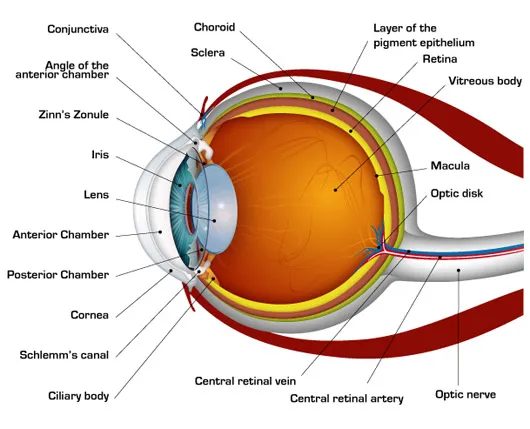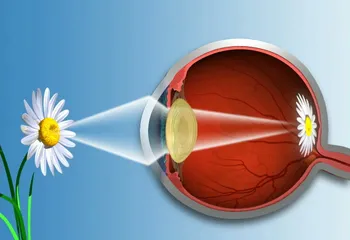Pinhole glasses are something of a phenomenon. They
allow anyone with blurry vision to see clearly - instantly
- without the need for corrective lenses.
You can test the concept right now. Make a fist and
put it up to one eye, with the other eye closed. Open
your fist just a tiny miniscule amount, just enough to
create a small hole to peep through. Amazingly, you can
now see clearly!
It's a bit miraculous, isn't it? What's more, there
is lots of anecdotal evidence to show that wearing pinhole
eyeglasses can improve your vision naturally in just
15 minutes each day. While optometrists have been reluctant
to carry out the necessary clinical trials to verify
this, my personal experience leaves me with little doubt
that pinhole glasses can improve vision naturally with
daily use.
In fact, I believe that pinholes are an excellent support
to daily vision training,
Pinhole glasses, or stenopic glasses, are an alternative
to conventional eyeglasses to improve vision. The shape
and design are similar to normal frames, but the difference
is in the lenses. Instead of a lens, pinhole glasses
have a series of pinhole-size perforations in a sheet
of plastic, and each hole allows only a small beam of
light to enter the eye.
Pinhole glasses are worn like normal glasses. Instead
of transparent glass or plastic for lenses, opaque black
plastic "lenses" are used. Wearers see through
small holes (pinholes) in the black plastic.
| Hello Lynne,
I thought I would share with you one of the benefits
I have found while using those pinhole glasses.
After using them for 3-5 minutes I notice that
my eyes seem to feel refreshed and cool,as if they
have just been bathed, instead of starting to feel
inflamed and itchy as is usal
Makes it so much easier to read for longer periods
of time
RJ Texas |
How the eye works:
Our ability to "see" starts when light reflects
off an object at which we are looking and enters the
eye. As it enters the eye, the light is unfocused. The
first step in seeing is to focus the light rays onto
the retina, which is the light sensitive layer found
inside the eye. Once the light is focused, it stimulates
cells to send millions of electrochemical impulses along
the optic nerve to the brain. The portion of the brain
at the back of the head (the visual cortex) interprets
the impulses, enabling us to see the object.

Click on picture for larger size
Light, refraction and its importance.
Light entering the eye is first bent, or refracted,
by the cornea -- the clear window on the outer front
surface of the eyeball. The cornea provides most of the
eye's optical power or light-bending ability.
After the light passes through the cornea, it is bent
again -- to a more finely adjusted focus -- by the crystalline
lens inside the eye. The lens focuses the light on the
retina. This is achieved by the ciliary muscles in the
eye changing the shape of the lens, bending or flattening
it to focus the light rays on the retina.

This adjustment in the lens, known as accommodation,
is necessary for bringing near and far objects into focus.
The process of bending light to produce a focused image
on the retina is called "refraction". Ideally,
the light is "refracted," or redirected, in
such a manner that the rays are focused into a precise
image on the retina.

Click picture for larger eye chart
Hi there,
Well you did warn me! Even though you encouraged
me to start slowly with the glasses and use them
for just a few minutes each time I took the bull
by the horns and did two hours to start with. As
you predicted the muscles in the back of my eyes
felt just like my legs when I first went back to
running and overextended them! However they quickly
settled down and I have really been aware of the
improvement in my eyesight so even when I forget
to take any glasses I can still read the menu in
the restaurant.
LG Oregon |
Most vision problems occur because of an error in how
our eyes refract light. In nearsightedness (myopia) the
light rays form an image in front of the retina. In farsightedness
(hypermetropia), the rays focus behind the retina. In
astigmatism, the curvature of the cornea is irregular,
causing light rays to focus to more than one place so
that a single clear image cannot be formed on the retina,
resulting in blurred vision. As we age, we find reading
or performing close-up activities more difficult. This
condition is called presbyopia, and results from the
crystalline lens being less flexible, and therefore less
able to bend light.


How
do Pinhole Glasses Work?
Pinhole glasses are a natural
form of vision correction, that can never harm your
eyesight.
In contrast, glasses and contact
lenses only correct your vision superficially and are
known to make your vision worse over time.
Contrary to their name, pinhole eyeglasses are not made
of glass or corrective lenses. They are simply black
plastic (or metal) with holes punched through where the
lens would normally be.
So, how do pinhole glasses
work?
In camera terms, pinhole glasses (also
called spectacles, eyeglasses and sunglasses) reduce
the effect of the eye's focusing errors by increasing
optical depth of field by reducing aperture size
Pinhole glasses work based on the concept that each
hole only allows a narrow beam of light through. This
reduces the size of the optical spot not coming into
perfect focus on your retina and increases your depth
of field.
| The unaided weak eye without Pinhole
Glasses |
|
| In a weak eye, light rays entering the eye's
lens are not all focused onto the same place
on the retina. For example rays a b f g, require
more focusing by the lens to hit the same plane
as rays c d e, which are nearer to the centre.
Rays c d e are usually always in focus, regardless
of the condition of the eye, and form a clear
image on the retina. This clear image is flooded
by the blurred image known as the "blur
circle" formed by rays a b f g. |
|
The unaided weak
eye with Pinhole Glasses |
|
| When the pinhole lens is used, only rays
c d e are allowed to form an image on the retina
and no blur circle is present to block the
clear image. Consequently, by using a lens
with multiple pinholes, many focused images
form on the retina and a clear, natural image
is seen. Also, no effort is required from the
eye muscles, as the only rays entering the
eye are already in focus. Hence there is a
dramatic consequential, relaxing effect. |
|
| Good day to you two,
What a hoot. I have just come back from the optomertrist
after having my eyes checked and he is STILL scratching
his head! He does not understand how my eyesight
seems to be imptoviong at the ripe old age of 77
and he definitely was not interested in investigating
my pinhole glasses !!
J D Montana |
Just look through any pin-hole and you'll
see what they mean. When you do this, blurred images
become focused. This is because the amount of peripheral
light rays (which are responsible for blurring) is reduced.
With appropriately spaced multiple pin-holes, you'll
get clear straight vision without the difficulty of concentrating
on a single hole. Regular use of these special pinhole
glasses helps exercise eye muscles and helps eyes relax
at the end of a tiring day and thus has a beneficial
effect. Particularly useful for those who spend a great
deal of time looking at computer and/or TV screens, Pinhole
Glasses help retrain your eye muscles, just as other
forms of exercise retrain muscles elsewhere.More
Info Here

What are Pinhole Glasses
For?
1. Prevent Computer Vision Syndrome - if you use computers
a lot you will recognize the signs: eye strain, dry eyes,
fatigue, headache, blurry vision and double vision. This
is all down to intense near point stress. Computer glasses
can reduce the glare from the monitor, help relax the
eyes, increase depth of field, and increase your natural
focusing power (also known as accommodation).
• Because of the way pinholes minimize light to
the eye, they work well as sunglasses or for extremely
bright conditions. They also work well in reducing the
visual stress of lengthy computer work
2. Relieve Eye Strain and Improve Your Vision - when
I wear pinhole eyeglasses, I get a clear long distance
focus without any eye strain. This is very supportive
for reducing myopia. In fact, some users report that
wearing pinhole glasses for just 15 minutes a day can
noticeably improve your vision in 4 weeks. If you have
farsightedness, you need simply read and write with pinholes
on, while nearsighted people need just sit back and watch
TV wearing pinholes.

Cataracts People
with cataracts often see better through pinholes. A cataract
doesn't allow light to enter the eye properly. Pinholes
often improve the vision even with the existence of the
cataracts.
Specialty Glasses
"When used for reading or other close work, pinholes
reduce the amount of accommodation or focusing power
that the eye must use to see clearly. There is an abundant
amount of research that points the finger at excessive
accommodation as the cause of acquired myopia.
It is clear that anything that can reduce this accommodative
effort, including pinhole glasses, is a useful weapon
in retaining good vision. It is for this reason, and
the fact that those in the optical business want nothing
to do with them, that we have decided to promote the
use of pinholes on this website. These glasses could
be a major tool in preventing myopia.
Its well proven Pinhole glasses make it easier to read
and do other close-up work. They easily take the place
of expensive prescriptions glasses, and they are durable
enough to last a lifetime.
Hi there,
Well you did warn me! Even though you encouraged
me to start slowly with the glasses and use them
for just a few minutes each time I took the bull
by the horns and did two hours to start with. As
you predicted the muscles in the back of my eyes
felt just like my legs when I first went back to
running and overextended them! However they quickly
settled down and I have really been aware of the
improvement in my eyesight so even when I forget
to take any glasses I can still read the menu in
the restaurant.
LG Oregon |
REMARKS OF AMERICAN DOCTORS
ON THE INVENTION
Dr. Janet Goodrich(a distinguished eye-sight-correcting
specialist)
" People with both close and distant blur and astigmatism are able to use
micohole sight correctors."
Dr. David Michael(author of Visual Optics and Refraction)
" Microholes reduce aberrations and light scattering, isolate a favorable
area of the damaged cornea and increase depth of focus."
Dr. Norman Bies(author of Correction of Subnormal Vision)
" The longer depth of focus obtained through microholes is well established
--- patients enjoy a substantial increase in reading distance." |

